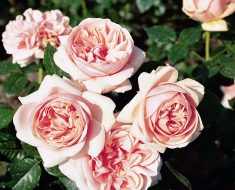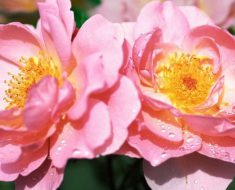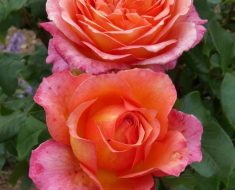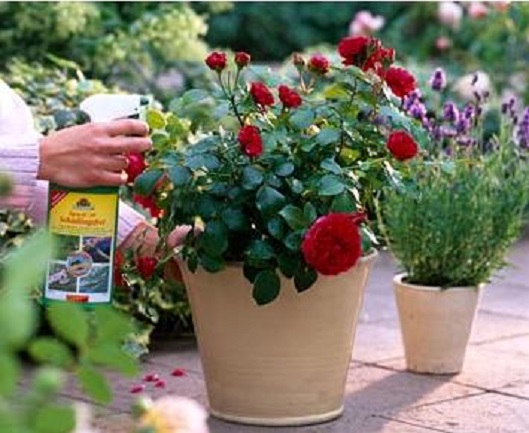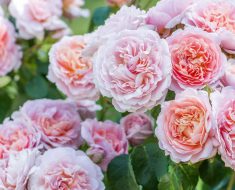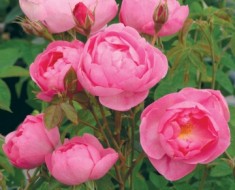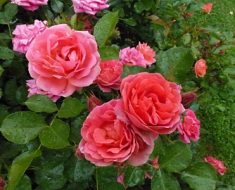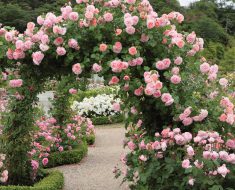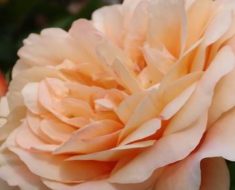English climbing rose SHROPSHIRE LASS is endowed with large simple flowers. It begins to bloom in early summer (depending on the weather conditions in the growing region). This is one of the varieties with the longest branches among climber D. Austin.
- Group – English Roses
- Subgroup – English Alba hybrids
- The main form is climber (climbing large-flowered rose)
- Height – from 4.5 m
- Diameter – from 90 cm
- Flower color – pale pink, fading to white
- Number of petals – 5-8
- Flower shape – simple
- Flower size – 10 -12 cm
- Blossom shape – clusters
- Flowering type – once blooming, but repetition is also possible
- Fragrance – medium intensity, myrrh
- Foliage – large, dark green, glosy
- Shoots – long, flexible, powerful strong, with thorns
- Features – beautiful with fruits in winter time; semi-double flowers may appear; can be found under the name Pink Ribbon; blooms well in partial shade
- Powdery mildew resistance – high
- Black stain resistance – high
- Cold resistance – 5–11 zones USDA
- Breeder – D. Austin
- Catalog name – SHROPSHIRE LASS
- Culture introduction year – 1968
- Soil – all types of
- pH – there may be slight fluctuations from neutral
- Drainage – obligatory
- Area – solar / partial shade
- Container – yes
- Stamb – no
- Types of planting – against the walls, on various supports: arches, pergolas, poles
Caring for a rose SHROPSHIRE LASS like this:
- Planting for roses is the most important stage of care from them. Plants prefer sunny areas with well-arranged drainage. They grow on almost all types of soil. The ground must be loose to allow enough water and air to flow to the root system. The roots of the English rose of a climbing rose SHROPSHIRE LASS are set in the planting pit so that they “look” from the support.
- Watering. Roses are watered as needed – from 15 liters of water to 1 adult shrub on average 2 to 3 times a week. In dry times, watering increases. If the plant grows in a container, then watering is more frequent. In both cases, it all depends on weather conditions.
- Fertilizers are fertilized at least 2-3 times during the growing season. It can be both mineral fertilizers and organic. Still roses varieties SHROPSHIRE LASS give mineral complexes, which are introduced by spraying. For roses growing in pots, fertilizing increases, but the doses used are lower.
- Pruning roses depends on the group to which it belongs. Adult roses are pruned in autumn, winter or early spring. Pruning is carried out to form the plant and prevent diseases or pests hiding under the bark of the plant. Pot roses are also pruned.
- Loosening and weeding the soil around the shrub roseberry SHROPSHIRE LASS is needed for air circulation, moisture and nutrients for the root system. To minimize your work, use mulching. This agrotechnical technique will help reduce the number of weeds and leave the soil moist longer. This applies to container roses.
- Shelter for the winter is especially necessary if the freezing temperatures are very low or in winter there are frequent long-term thaws that are abruptly replaced by minus. Be sure to cover the English rose SHROPSHIRE LASS, growing in a container.
- Main types of lavender
- Most fragrant roses
- ITALIAN GARDEN AT THE LANDSCAPING DESIGN
- FRENCH REGULAR GARDEN
Enjoy your cultivation!
